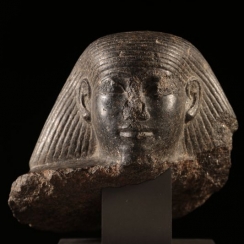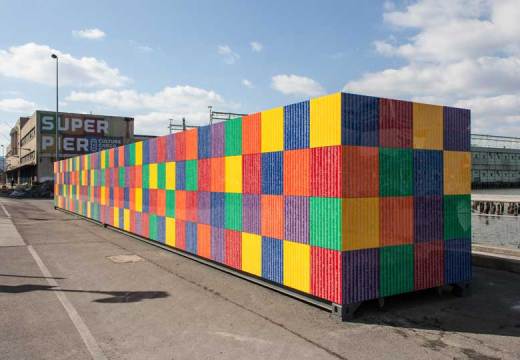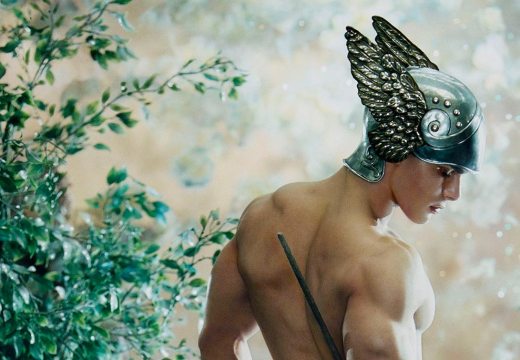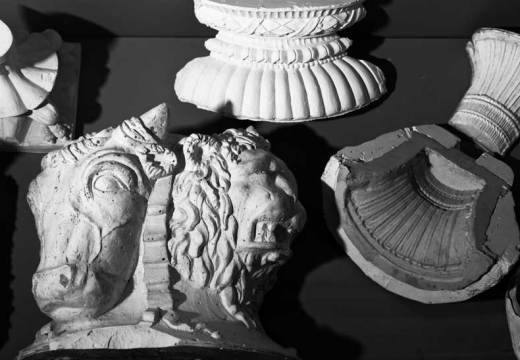There are the star works that are drawing crowds at TEFAF this year. Damien Hirst’s ram in a formaldehyde box at Tomasso Brothers Fine Art is one such spectacle, as is Van Gogh’s Le Moulin de la Galette at Dickinson Fine Art, which goes on sale after nearly half a century in private ownership. Painted in 1887 and first shown in Amsterdam 15 years after his death, it is seen as marking a turning point in the artist’s familiar, vivid style.
These are among the must-sees that everyone’s talking about, but there is so much more besides. With the second and final weekend of TEFAF 2014 looming, we asked a selection of galleries to pick out further highlights from their stands.
Rupert Wace Ancient Art Ltd.
According to Claire Brown, Associate Director, three top pieces were sold in the first three days when most of the business is done, although the fair ‘keeps you on your toes’ as each day nevertheless brings new collectors. Brown’s current highlight, and one she is ‘passionate about’, is a c. 2nd–1st century BC marble torso of an athlete. ‘I’d be surprised if it’s still here by the end of the week’.
Rossi & Rossi
Fabio Rossi explains how an 11th century mandala is the earliest Tibetan example, and that it is ‘a cornerstone of early Tibetan paintings’. Rich in detail without being overtly elaborate, it signals the second diffusion of Buddhism in Tibet and has a ‘tremendous power of drawing you in’. According to Rossi: ‘I sold the painting in 1991 and so it’s nice to get it back!’ The work was previously exhibited in ‘Himalayas: An Aesthetic Adventure’ at The Art Institute of Chicago in 2003.
Charles Ede Ltd.
The Greek bronze helmet of Corinthian type on show here has ‘been getting a lot of attention’. Skilfully hammered from a single sheet of bronze – remarkable given that the nose piece is thicker than the back – this work dates from the 6th century and can be seen as the prototype for all Greek helmets to follow. Also on show, and the gallerist’s personal highlight, is a mid-1st-century Roman Republican marble portrait of a head. Less idealised and more realistic than early imperial works, Republican portraits are rare on the market.
Robilant + Voena
Normally exhibiting Old Masters, Robilant + Voena’s stand this year is remarkable for its juxtaposition of old and new, with TEFAF offering the chance for a bold display. Fontana is well represented; the highlight the gallerists draw my attention to is an unusually shaped, gold slash canvas from the artist’s Quanta cycle, dating from 1959. For this series Fontana created the works in different shapes, allowing collectors to choose one according to their tastes, and thus amounting to genuinely ‘open works’. For Old Masters, look no further than Canaletto’s elegant Venetian view of the Torre di Marghera, previously exhibited in the National Galleries of London and Washington.

Head of a block statue, Egypt, Thebes, New Kingdom, Reign of Amenhotep, c. 1428–1397 BC. Axel Vervoordt
Axel Vervoordt
Noach Vander Beken at Axel Vervoordt points out their deliberate pairing of archaeological treasures and contemporary art, which sees Fontana, and Gutai artists such as Kazuo Shiraga situated alongside antiquities. The real highlight here is an Egyptian head of a block statue which has – unsurprisingly – already been sold to a US museum. The remarkably preserved piece is the remainder of a granodiorite block statue believed to originate from the New Kingdom, XVIIIth Dynasty and is dated c. 1428–1397 BC.
Fine Art Society
Whilst the ‘best work we have’ is The Beggar’s Opera II (1728), one of Hogarth’s first works in oil, the ‘most fun’, and the one that has been stopping people in their tracks, is the grotesque ceramic sculpture – suitably titled Fantastical Grotesque Beastie – by the Martin Brothers. Executed in c. 1890, this highly collectible work is a one-off. It has not been on the market for 50 years.
Lowell Libson
The obvious highlight here is John Flaxman’s remarkable relief marble carving depicting the Adoration of the Magi (c. 1792–94). Also looking more contemporary than its date suggests is James Nasmyth’s black and white chalk drawing of the surface of the moon, surprisingly executed in c. 1850.
Sperone Westwater
Picking out Swiss artist Jean Tingueley’s Radio No. 1 (1960), Assistant Director Juliette Premmereur tells me that the work was gifted to Rauschenberg by the artist – the two had a long friendship. Radio No. 1 is a ramshackle, albeit working, radio, whose appeal lies precisely in its very haphazard functionality. Premmereur also shows me contemporary artist Jan Worst’s large oil Divine Detail (2014), situated on the outside of the stand and whose photographic realism has been drawing large crowds. Staged in opulent settings, Worst’s figures seem out of place, contemporary men and women at odds with their historical surroundings.
Galerie Jacques de la Béraudière
I am told that one of the highlights here, a Hans Arp surrealist sculpture from 1924–26, sold on the first day of the fair for more than £1 million. There is, however, a Chaïm Soutine oil titled L’Arbre de Vence (c. 1929) which is picked out as a current highlight, for the way it signals a change in the artist’s depiction of landscape. Working at Vence during 1928–29, Soutine produced a series of landscapes more stable and balanced than his earlier turbulent Céret works.
Hans P. Kraus
The selection of beautiful, otherworldly photographs on offer here makes, I imagine, choosing one highlight almost impossible. Alongside Sir John Herschel’s delicate camera lucida drawing of Stonehenge from 1865, we settle on Charles Nègre’s 1853 salt print Le tailleur de pierre. Here, by using a brief exposure, Nègre creates a moment frozen in time. A compositionally posed picture, Nègre clearly drew on his formal training as a painter.
TEFAF 2014 runs until 23 March. Click here for more highlights from the fair
Unlimited access from just $16 every 3 months
Subscribe to get unlimited and exclusive access to the top art stories, interviews and exhibition reviews.
























![Masterpiece [Re]discovery 2022. Photo: Ben Fisher Photography, courtesy of Masterpiece London](http://www.apollo-magazine.com/wp-content/uploads/2022/07/MPL2022_4263.jpg)
It’s time for the government of London to return to its rightful home